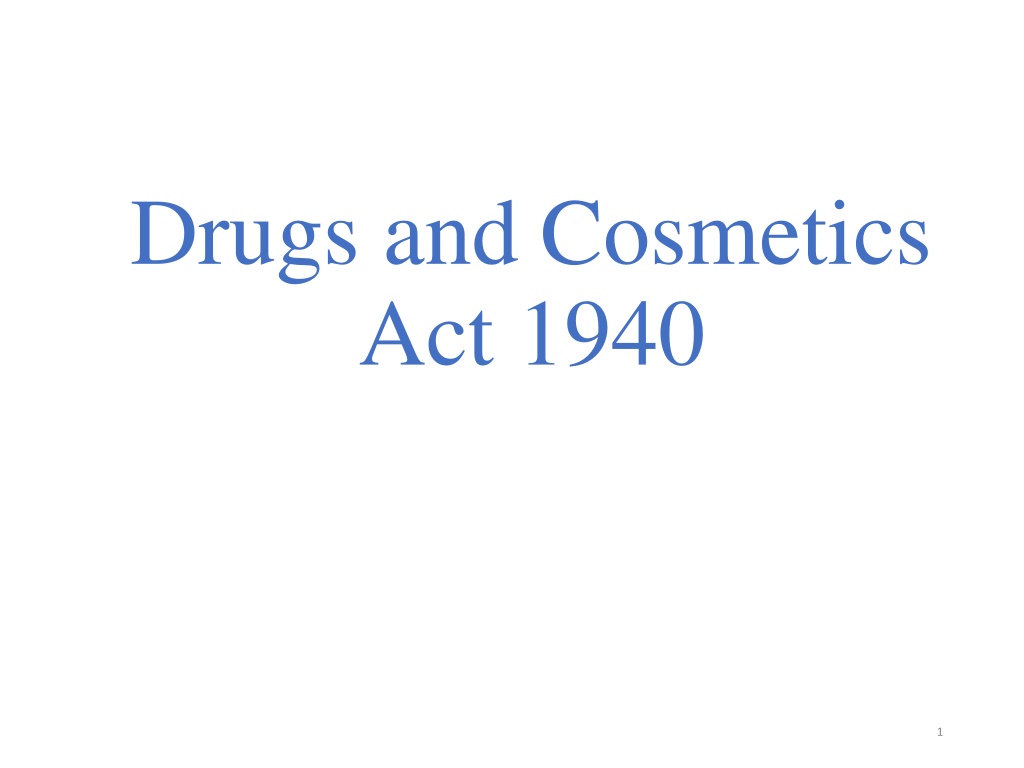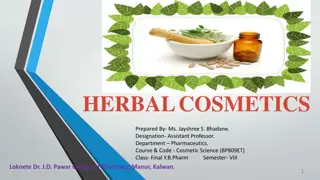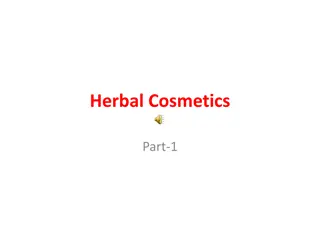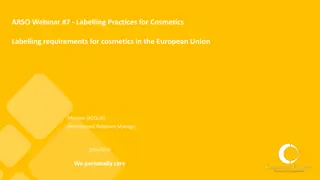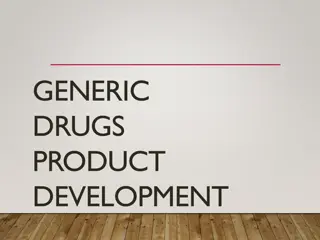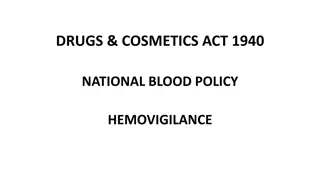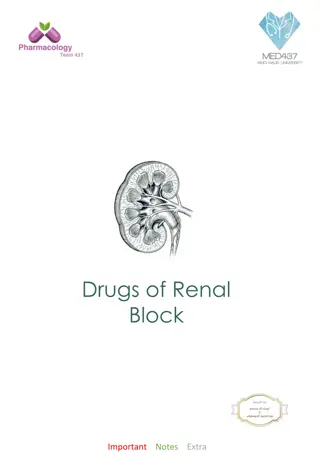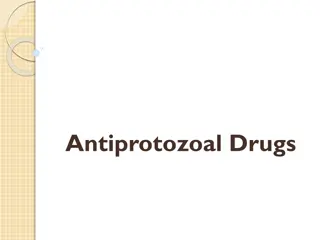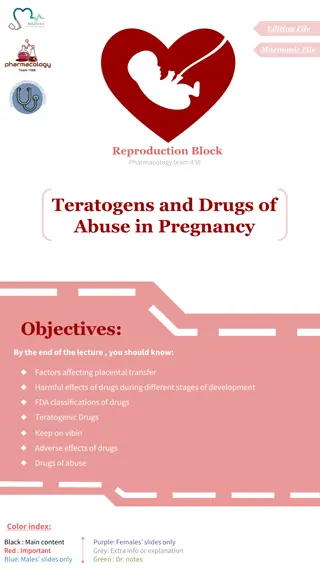Overview of Drugs and Cosmetics Act, 1940
The Drugs and Cosmetics Act of 1940 was enacted to regulate the import, manufacture, distribution, and sale of drugs and cosmetics in India. The Act aims to ensure high standards of medical treatment, prevent substandard drugs, and establish advisory boards for different types of drugs. It sets out provisions related to import, manufacture, sale, labeling, and packaging of products, with stringent penalties for non-compliance. The history, objectives, key features, and definitions of the Act are outlined in detail.
Download Presentation

Please find below an Image/Link to download the presentation.
The content on the website is provided AS IS for your information and personal use only. It may not be sold, licensed, or shared on other websites without obtaining consent from the author.If you encounter any issues during the download, it is possible that the publisher has removed the file from their server.
You are allowed to download the files provided on this website for personal or commercial use, subject to the condition that they are used lawfully. All files are the property of their respective owners.
The content on the website is provided AS IS for your information and personal use only. It may not be sold, licensed, or shared on other websites without obtaining consent from the author.
E N D
Presentation Transcript
Drugs and Cosmetics Act 1940 1
Contents Introduction History and Objectives Definitions Administration of the act and rules Provisions related to Import Provisions related to Manufacture Provisions related to Sale Labeling and Packaging Schedules to the act and rules
INTRODUCTION CHAPTER I INTRODUCTORY CHAPTER II THE DRUGS TECHNICAL ADVISORY BOARD, THE CENTRAL DRUGS LABORTORY AND COMMITTEE CHAPTER III IMPORT OF DRUGS ANDCOSMETICS CHAPTER IV MANUFACTURE, SALEAND DISTRIBUTION OF DRUGS AND COSMETICS THE DRUGS CONSULTATIVE 3
CHAPTER IVA PROVISIONS RELATING TO AYURVEDIC SIDDHA AND UNANI DRUGS CHAPTER V MISCELLANEOUS 4
History British misrule-Providing poor healthcare system to Indiancitizens Observations made by-Drugs Enquiry Committee, Indian MedicalAssociation Reports in- Indian Medical Gazette during1920-30 1940 Drugs and CosmeticsAct 1945 Rules under the Act Extended to whole ofIndia 5
Objectives To regulate the import, manufacture, distribution and sale of drugs & cosmetics through licensing. Manufacture, distribution and sale of drugs and cosmetics by qualified personsonly. To prevent substandard in drugs, presumably for maintaining high standards of medical treatment. To regulate the manufacture and sale of Ayurvedic, Siddha and Unani drugs. To establish Drugs Technical Advisory Board(DTAB) and Drugs Consultative Committees(DCC) for Allopathic and allied drugs andcosmetics. 6
The salient features of the Drugs & Cosmetics Act, 1940 are as follows: a) Maximum penalty life imprisonment and fine of Rs. 10 lakhs or 3 times thevalue of the confiscated goods, whichever ismore. b) Some of the offences cognizable andnon-bailable. c)Besides officers from the Drug Controller s Office, other gazette officersalso authorized to launch prosecution under theAct; d) Specially designated courts for trial of offences covered under theAct; e) Provision for compounding of minoroffences. 7
Definitions Drugs : All medicines for internal or external use of human beings or animals and all substances intended to be used for or in the diagnosis, treatment, mitigation or prevention of any disease or disorder in human beings oranimals. 8
Cosmetic : Any article intended to be rubbed, poured, sprinkled or sprayed on, or otherwise applied to, the human body or any part thereof for cleansing, beautifying, promoting attractiveness, or altering the appearance, and includes any article intended for use as a component of cosmetic. 9
Misbranded drugs : a) if it is so coloured, coated, powdered or polished that damage isconcealed b) if it is not labelled in the prescribed manner;or c) if its label or container or anything accompanying the drug bears any statement, design or device which makes any false claim for the drug or which is false or misleading in any particular. 10
Adulterated drug : (a)if it consists, in whole or in part, of any filthy, putrid or decomposed substance; or (b)if it has been prepared, packed or stored under insanitary conditions whereby it may have been contaminated with filth or whereby it may have been rendered injurious to health;or (c)if its container is composed in whole or in part, of any poisonous or deleterious substance which may render the contents injurious tohealth. 11
Spurious drugs : (a) if it is imported under a name which belongs to another drug;or (b)if it is an imitation of, or a substitute for, another drug or resembles another drug in a manner likely to deceive or bears upon it or upon its label or container the name of anotherdrug.or (c) if it has been substituted wholly or in part by another drug orsubstance. 12
Manufacture : In relation to any drug or cosmetic, it includes any process or part of a process for making, altering, ornamenting, finishing, packing, labelling, breaking up or otherwise treating or adopting any drug or cosmetic with a view to its sale or distribution but does not include the compounding or dispensing of anydrug. 13
Patent or Proprietary medicine : A drug which is a remedy or prescription presented in a form ready for internal or external administration of human beings or animals and which is not included in the edition of the Indian Pharmacopoeia for the time being or any other Pharmacopoeia authorized in this behalf by the CentralGovernment. 14
Administration of the act and rules A)Advisory : 1)Drugs Technical AdvisoryBoard-DTAB 2)Drugs ConsultativeCommittee-D.C.C. B)Analytical : 1)Central Drugs Laboratory - CDL 2)Drug Control Laboratory instates 3)Government Analysts C) Executives : 1)Licensing authorities 2)Controlling authorities 3)Drug Inspectors 15
Drugs Technical AdvisoryBoard(DTAB) Ex-Officio: (i) Director General of Health Services(Chairman) (ii) Drugs Controller, India (iii)Director of the Central Drugs Laboratory,Calcutta (iv)Director of the Central Research Institute, Kasauli (v)Director of Indian Veterinary Research Institute,Izatnagar (vi) President of Medical Council ofIndia (vii)President of the Pharmacy Council of India (viii)Director of Central Drug Research Institute,Lucknow 16
Nominated: 1) Two persons by the Central Government from among persons who are in charge of drugs control in theStates 2) One person by the Central Government from the pharmaceuticalindustry 3)Two persons holding the appointment of Government Analyst under this Act, to be nominated by the Central Government 17
Elected: 1)one person, to be elected by the Executive Committee of the Pharmacy Council of India, from among teachers in pharmacy or pharmaceutical chemistry or pharmacognosy on the staff of an Indian university or a collegeaffiliated. 2)one person, to be elected by the Executive Committee of the Medical Council of India, from among teachers in medicine or therapeutics on the staff of an Indian university or a college affiliated. 3)one pharmacologist to be elected by the Governing Body of the Indian Council of Medical Research. 4)one person to be elected by the Central Council of the Indian Medical Association. 5)one person to be elected by the Council of the Indian Pharmaceutical Association. 18
Functions: To advise the Central Government and the State Governments on technical matters arising out of the administration of thisAct. To carry out the other functions assigned to it by thisAct. (The nominated and elected members of the Board shall hold office for three years, but shall be eligible for re-nomination andre-election) 19
Drugs Consultative Committee(DCC) It is also an advisory body constituted by centralgovernment. Constitution: Two representatives of the Central Government One representative of each StateGovernment 20
Functions: To advise the Central Government, the State Governments and the Drugs Technical Advisory Board on any other matter tending to secure uniformity throughout India in the administration of thisAct. The Drugs Consultative Committee shall meet whenrequired Has power to regulate its own procedure. 21
Central Drug Laboratory(CDL) Established in Calcutta, under the control of a director appointed by the Central Government Functions: Analysis or test of samples of drugs/cosmetics sent by the custom collectors or courts. Analytical Q.C. of the importedsamples. Collection, storage and distribution of internalstandards. Preparation of reference standards and theirmaintenance. Maintenance of microbialcultures. Any other duties entrusted by CentralGovernment. Acting as an appellate authority in matter ofdisputes. 22
Import of Drugs Classes of drugs prohibited to import Import of drug underlicense 1)Specified in Schedule-X 2)Any new drugs Drugs exempted from provisions ofimport Offences and Penalties 23
Classes Of Drugs Prohibited ToImport Misbranded drugs Drugs of substandardquality Drugs claiming to cure diseases specified in Sch-J Adulterated drugs Spurious drugs Drugs whose manufacture, sale/distribution are prohibited in original country, except for the purpose of test, examination and analysis. Patent/Proprietary medicines whose true formula is notdisclosed. 24
Import of the biological drugs(C/C1) Conditions to be fulfilled: Licensee must have adequate facility for thestorage. Licensee must maintain a record of the sale, showing the particulars of the names of drugs and of the persons to whom they have beensold. Licensee must allow an inspector to inspect premises and to check therecords. Licensee must furnish the sample to theauthority. 25
Import of the Schedule-X drugs (Narcotic & Psychotropic drugs) Conditions to be fulfilled: Licensee must have,adequate storagefacility. Applicant must be reputable in the occupation, trade orbusiness. The license granted ever before should not be suspended orcancelled. 26
Drugs Imported for examination, test or analysis Conditions to be fulfilled: License is necessary under form-11 Must use imported drugs only for said purpose and at the place specified in the license. Must keep the record with respect to quantities, name of the manufacturer and date of import. Must allow an inspector to inspect the premises and check therecords. 27
Import of cosmetics Cosmetics prohibited to import: Misbranded cosmetics Spurious cosmetics Cosmetic containing harmfulingredients Cosmetics not of standard quality which contains more than-2 ppm Arsenic, 20 ppm lead, 100 ppm heavymetals 28
Penalties related to Import OFFENCES PENALTIES Import of spurious OR adulterated drug OR drug which involves risk to human beings or animals OR drug not having therapeutic values a) 3 years imprisonment and 5000 Rs. fine on first conviction b) 5 years imprisonment OR 1000 Rs. fine OR both for subsequentconviction Contravention of theprovision a) 6 months imprisonment OR 500 Rs. fine OR both for firstconviction b) 1 year imprisonment OR 1000 Rs. fine for subsequent offence 29
Prohibition of manufacture Drug not of standard quality or misbranded, adulterated orspurious. Patent or Proprietarymedicine. Drugs which claims to cure diseases specified inSch-J. Drugs which Risky to human beings oranimals. Drugs without therapeuticvalue. 30
Types of manufacturing license Allopathic Drugs Sch.- C/C1 But not -X Sch.-X Other than Sch.- C/C1& X Sch.-C/C1& X Drugs for the purpose of examinationtest oranalysis Own Premises Own Premises Loan License Own Premises Repacking license 31 31
Manuf. of drugs other than in Sch-C/C1 Conditions: Premises should comply with schedule M . Adequate facility for testing, separate frommanufacturing. Adequate storagefacility. Records of mfg. & testing-maintained for at least 2 years from date ofExp. License should provide sample toauthority. Furnish data of stability. Maintain the inspectionbook. Maintain reference samples from each batch. Accounts of production recorded & maintained for 5 years or 1 year after Expiry. 32
Manufacture Of Sch-X drugs Conditions: Have to sent invoice of sale to licensing authority every 3 months Store drugs in direct custody of responsible person. Preparation must be labeled with XRx Marketed in packing not exceeding 100 unit dose Tablets/Capsules 300 ml- Oral liquid 5 ml - Injection 33
Manuf. of drugs those in Schedule- C/C1(Biological) Conditions: Drugs must be issued in previously sterilized sealed glass or suitablecontainer Containers should comply with req. ofSch-F/F1 Drug must comply with std. (quality, purity, strength) specified insch.-F Parenteral in doses of 10 ml or more should be tested for freedom from Pyrogens Separate lab. for culture & manipulation of spore bearingPathogens Test for sterility should be carriedout. 34
Penalties related toManufacture OFFENCES PENALTIES Manufacture of any spuriousdrugs a) 1-3 years imprisonment and Rs.5000 fine b) 2-6 years imprisonment & Rs.10000 fine on subsequentconviction Manufacture of adulterateddrugs a) 1 year imprisonment & Rs.2000 fine b) 2 years imprisonment & Rs.2000 fine for subsequentconviction Manuf. of drugs in contravention of the provisions a) Imprisonment up to 3 months & Rs.500 fine b) Imprisonment up Rs.1000 fine on subsequentconviction to 6 months & 35
Loan License Definition: A person(applicant) who does not have his own arrangements(factory) for manufacture but who wish to avail the manufacturing facilities owned by another licensee. Such licenses are called Loan licenses. Procedure: Licence is obtained from licensing authority (FDA) on application in prescribed forms (24-A , 27-A) with prescribed fees (Rs. 6000,1500). 36
Repackaging license Definition: Process of breaking up any drug from a bulk container into small packages and labeling with a view to their sale and distribution. Repackaging of drugs is granted of drugs other than Schedule-C/C1 and X. Procedure: Licence is obtained from licensing authority (FDA) on application in prescribed forms (24-B) with prescribed fees (Rs. 500,200). 37
TYPES OF SALESLICENCES Allopathic Drugs Whole Sale Retail Sale Sales From MotorVehicle (Vender) Restricted Licence General Licence Drugsin Sch.- C/C1 Drugs in Sch.- X For Sch.- C/3 C 81 Drugs otherthan sch.-C/C1
Classes of drugs prohibited to be sold Misbranded, spurious, adulterated and drugs not of standardquality Patent/Proprietary drugs with undisclosedformula Sch-J drugs Expired drugs. 39
Wholesale Of Biological (C/C1) Adequate premises, with greater than 10 M2 area, with proper storagefacility Drugs sold only to retailer havinglicense Premises should be in charge of competent person who is Reg.Pharmacist. Records of purchase &sale Records preserved for 3 years from date ofsale License should displayed on premises 40
Wholesale Of Other ThanThose Specified In C/C1 And X All the conditions as discussed in forbiological. Compounding is made by or under the direct and personal supervision of a qualified person. 41
Retail sale For retail sale, two types of licenses are issued: i) General licenses ii) Restricted licenses Restricted license: Granted to those dealers who do not engage the services of a qualified person and only deal with such classes of drugs whose sales can be effected without qualified person and vendors who do not have fixedpremises. 42
Labeling & Packaging All the general and specific labeling and packaging specified to all classes of drugs and cosmetics should be as per the provisions made under theact. 43
Schedules to the rules TYPE CONTENT Performa for forms no. 1 to 50( Application, issue, renewal,etc.) A Rates of fee for test or analysis by CDL or Govt.analysts B List of Biological and special products (Injectable) applicable to special provisions. Ex. Sera, Vaccines,Penicillin ..etc List of Biological and special products (nonparenteral) applicable to special provisions. Ex. Digitalis, Hormones , Ergot List of drugs that are exempted from provisions ofimport C C1 D List of poisonous substances under the Ayurvedic , Siddha and Unani systems Provisions applicable to bloodbank E1 F 44
Schedules to the rules TYPE CONTENT Special provision applicable to biological and special products, e.g. Bacterial and viral vaccines, sera from living animals, bacterial origin diagnostic agents F1 Standards for surgicaldressings F2 Standards for umbilicaltapes F3 Standards for ophthalmicpreparations FF List of substances required to be used under medical supervision and labelled accordingly Ex. Metformin, Anti Histaminic, etc. G List of substances (prescription) that should be sold by retail only on prescriptions of R.M.P. Ex. Atenolol, Lorazepam, Dapson etc. H 45
Schedules to the rules CONTENT TYPE List of diseases and ailments that drug should not claim tocure Ex. Cancer, AIDS, Cataract,Diabetes etc List of drugs that are exempted from certain provisions regarding manufacture Requirements of manufacturing premises, GMP requirements offactory premises, plants and equipments Requirements of factory premises for manufacture ofHomeopathic medicines Requirements of factory premises for manufacture ofcosmetics J K M M1 M2 Requirements of factory premises for manufacture of medicaldevices M3 List of equipment to run a Pharmacy N Standards for disinfectant fluids Ex Phenol, H2O2,alcohol . O 46
Schedules to the rules TYPE CONTENT Life period(expiry) of drugs Ex. Insulin Inj. 24months P Coal tar colors permitted to be used in cosmetics Ex. Caramel,TiO2, Toney red .. Standards for mechanicalcontraceptives Q R Standards for medicaldevices R1 Standards forcosmetics S Requirements (GMP) of factory premises for Ayurvedic, Siddha, Unani drugs T Manufacturing and analytical records ofdrugs U 47
Schedules to therules TYPE CONTENT Manufacturing and analytical records ofcosmetics U1 Standards for patent or proprietarymedicines V List of drugs marketed under generic names-Omitted W List of narcotic drugs and psychotropicsubstances EX. Opium, Morphine, Barbital X Requirement and guidelines on clinical trials for import and manufacture of new drugs Y 48
